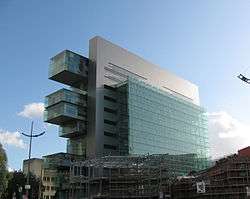Gateway House, Manchester
| Gateway House | |
|---|---|
 Gateway House and Piccadilly Station approach | |
| Alternative names | Piccadilly House |
| General information | |
| Architectural style | Modernist |
| Location | Manchester, England |
| Current tenants | empty |
| Completed | 1969 |
| Renovated | Coming soon |
| Owner | Realty Estates |
| Height | 36 m (118 ft) |
| Technical details | |
| Floor count | 9 |
| Floor area | 12,861 m2 (138,430 sq ft) |
| Design and construction | |
| Architect | Richard Seifert |
| References | |
| [1] | |
Gateway House in Manchester, England, is a modernist office block above a row of shops designed by Richard Seifert & Partners and completed in 1969. It replaced a row of 19th-century railway warehouses on the approach to Manchester Piccadilly station. The building, which differed from much of Seifert's contemporary work in that it departed from the bare concrete brutalist style which had become his trademark, was nicknamed the "lazy S" was reputedly designed as a doodle.
It is considered to be one of Siefert's most loveable buildings,[2] commanding respect from Clare Hartwell, who described it as
| “ | a very impressive long, sweeping, undulating façade, the horizontals stressed throughout. One of the best office blocks in Manchester, its glittering serpentine shape well suited to the sloping site.[3] | ” |
Future
The building was bought by Realty Estates in 2008.[4] Hodder + Partners won a competition to redevelop Gateway House in 2009. The plans are for the landmark structure to be converted into a hotel at a cost of £20 million. An office block with ground floor retail space on Ducie Street and a gym behind the Seifert building would be the second phase of the development.[5] In December 2011, the £35 million redevelopment scheme by Hodder + Partners for Realty Estates, was given planning approval by Manchester City Council.
Despite planning approval, redevelopment has not started. In June 2014, the building was sold to international property group, LaSalle for £26m.[6] A new let was agreed with Waitrose and work could begin on renovating the building with a new hotel operator.[7]
A major redevelopment of the neighbouring Piccadilly Station and the surrounding area has been proposed to complement the planned construction of the High Speed 2 (HS2) railway line to Manchester. The project would involve the construction of a large new canopy over the HS2 platforms and the creation of a new entrance to the station.[8][9] As part of the HS2 redevelopment plans it is likely that Gateway House will be demolished.[10]
Refurbishment commenced in October 2015.
| Wikimedia Commons has media related to Gateway House. |
References
Notes
- ↑ Gateway House, skyscrapernews.com, retrieved 29 November 2011
- ↑ Gateway House, Manchester Modernist Society, retrieved 12 September 2012
- ↑ Hartwell 2001, p. 217
- ↑ "Plans put forward for £35m revamp of Gateway House". Manchester Evening News. Retrieved 29 November 2011.
- ↑ Hodder bags planning for £35million overhaul of Seifert's Gateway House, Architects Journal, retrieved 12 September 2012
- ↑ "Tishbi sells Gateway House for £26m". Place North West. 27 June 2014. Retrieved 2014-10-24.
- ↑ "Aparthotel secured for Gateway House". Place North West. 15 September 2014. Retrieved 2014-10-24.
- ↑ "Mayfield SRF" (PDF). Bennetts Associates. 2014. Retrieved 21 March 2015.
- ↑ "Portfolio: HS2 Manchester Strategic Regeneration Framework". Bennetts Associates. Retrieved 22 March 2015.
- ↑ Charlotte Cox, Charlotte (3 January 2014). "Manchester politicians dismiss claims Piccadilly Station's 'Lazy S' building is 'iconic' in row about its potential demolition". Manchester Evening News. Retrieved 22 March 2015.
Bibliography
- Hartwell, Clare (2001), Manchester, Pevsner Architectural Guides, London: Penguin, ISBN 0-14-071131-7
Coordinates: 53°28′42″N 2°13′55″W / 53.4784564°N 2.2318447°W




